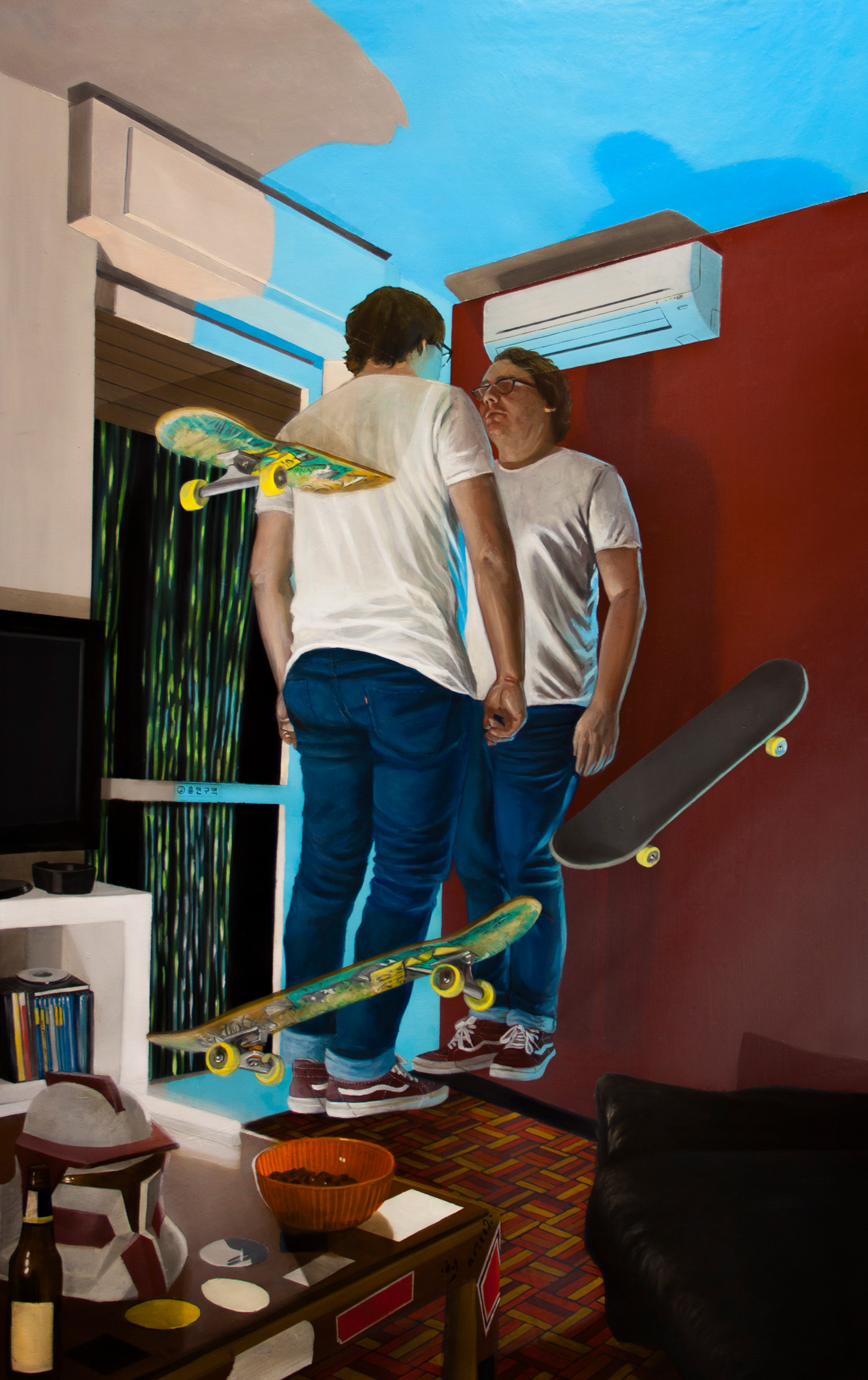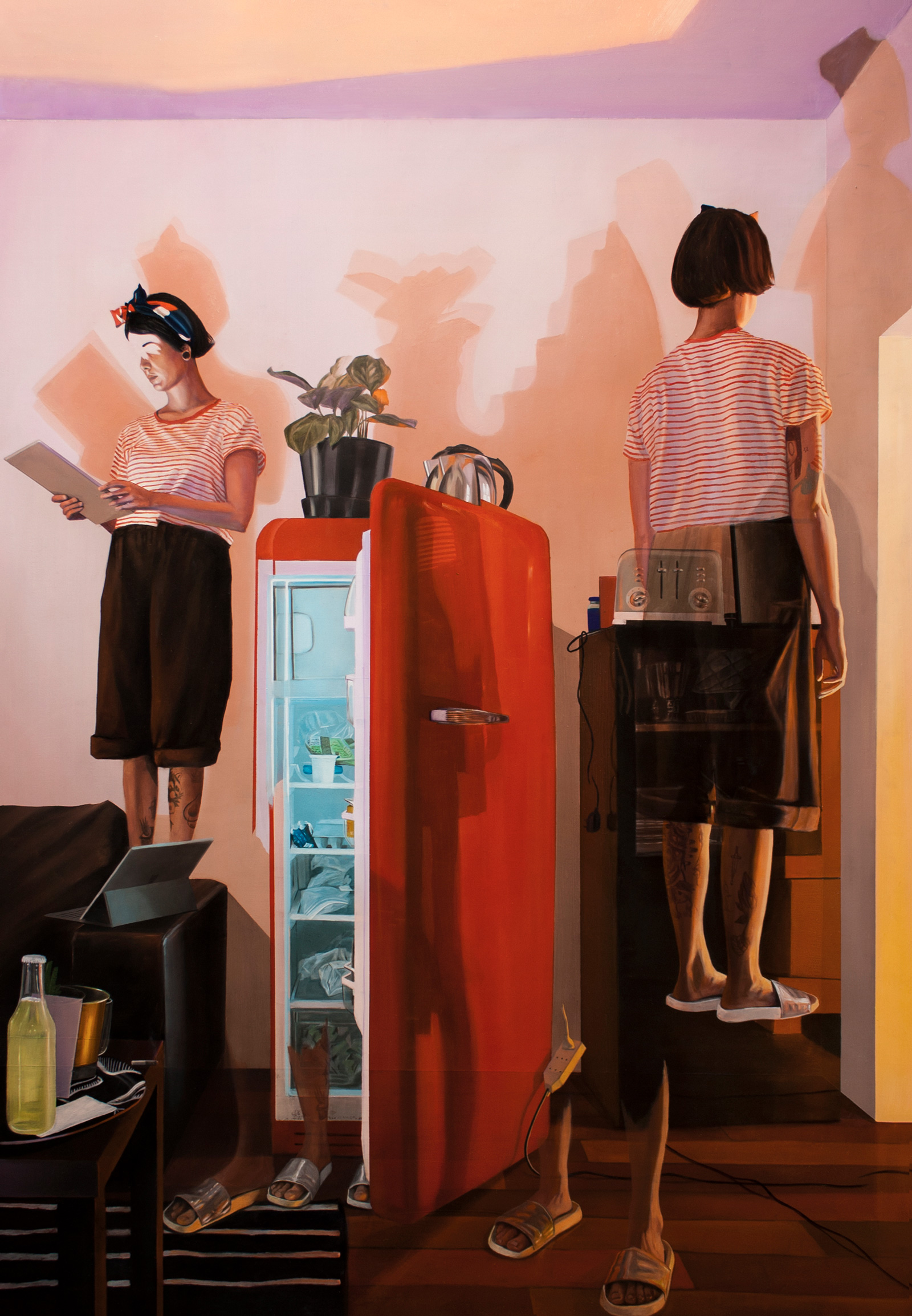Life’s a rollercoaster. A rollercoaster that always flows along a foreseen track, yet ushers tosses and turns that seemingly come out of nowhere. But you already knew that. Despite our awareness of life’s uncertainty, we often fail to remember that uncertainty is life’s only certainty. Remembering this helps buffer the shock, but there seems to be a reoccurring theme in this dilemma — that our past both as individuals and as a society, is in constant flux.
Following along this rabbit hole of thought, the idea of our collective conscious, our collective memory and our objective reality begins to come into question. Questions that Italian artist Dario Maglionico taps into within every one of his self-referential paintings. I visited Maglionico at his Milan studio to further discuss this dialogue with the past.
 Discuss your aesthetic and what you aim to achieve through your art?
Discuss your aesthetic and what you aim to achieve through your art?
I’m a figurative painter and my stylistic choice helps me to recreate the illusion of reality. Paintings are an illusion, a composition of colors. They are nothing more than what you see on the palette, it is exactly the same material. I love this connection with reality — you have your vision, your perception, your illusion that for sure is not the real one because it isn’t the only one.
I think that art can only show the way, ask questions. It is up to us to give our answers. It needs the viewer and their perception.
The subjects within your work appear in a way where they’re neither here nor there? Can you explain this further?
I work with time and space, along with the perception of reality around us. I think there is only one perception. Everything that we feel about reality which circulates around our brains, begins to form our identity. So the memory of these moments is like a synchronic view of what we perceived. For example, we are here right now…I saw you, I saw that then I changed my point of view and with that change came a change in plane and perspective.
You moved, I moved and things are constantly changing. So when I begin to study these memories, I start from the beginning. At first, I may have been inspired by the light cast. I never draw the background or figures. Going through the process of getting a painting done, does it start with a memory in your head — perhaps one of your own, which you end up sketching and painting. What is your current routine like?
Going through the process of getting a painting done, does it start with a memory in your head — perhaps one of your own, which you end up sketching and painting. What is your current routine like?
It can happen anywhere really — at my friends’ house, my house, or even this bar. I take a photograph and sometimes at home I’ll look at my phone and be surprised, like “Oh that was an interesting spot,” and I begin to analyze the space. I like the door here or the geometry of the room and I begin to make a composition by sketching it. Then I change the perspective of the same room by taking a photograph ‘here’ then ‘there’. The composition will essentially evolve out of these photographs in which I begin to alter in photoshop. Quality at this stage doesn’t quite matter because I will perfect it in the painting.
I try to include the things that hit me from the photograph and memory.
Such as the dominant themes. Say you were going to paint the scene we’re in now, you would paint like…
Yeah, like your hands on the table, the barista’s purple hair… Not all your work, but there certainly are some paintings which carry a dark presence about them. Is this sentiment carried throughout all your work?
Not all your work, but there certainly are some paintings which carry a dark presence about them. Is this sentiment carried throughout all your work?
There are two series within my work — the light and the dark.
My interest in light brings me to work on darkness. In these paintings, there is always a little source of light that fascinates you and at the same time allows you to understand the space. We need this little spark of light that helps us to understand. I love the darkness because it forces you to start from zero and rebuild everything. It plays with your perception more deeply. Now I’m working on the colorful light for the same reason — a new way to investigate the space. You have to follow every reflection all around the room, painting and watching it.
What about the changing of perspective you illustrate in your paintings?
Wide vanishing points, various points of view, and plans intersections make the viewer’s perception vary, suggesting every time a different way to approach the canvas. Figures also incite this attitude, as their sudden disappearing is functional to the recognizing of something else behind them. Even if their poses might be bizarre, they reflect the will to pose questions to the beholder: Where are you? What are you looking at? Who are you? Could you look at yourself by a different point of view?
Our memories are stuck to our brain by the synchronic union of at least two senses: a scent, a particular situation or voice tune, which makes up one element. The second is this sense of overwriting which makes the complete memory. My paintings are like a transposition of these memories, synchronies of a life which is the meeting point of every single past or present moment inside of it. So your thoughts and feelings about these memories are only yours. All your paintings and images are your own memories, correct?
So your thoughts and feelings about these memories are only yours. All your paintings and images are your own memories, correct?
No, all my own images. In the past, I’ve seen images on the internet but my point of view is the best way to express my art. My reconstruction of the situation.
I think an interesting point to tangent back to is time, because memories deal with time. Living in a country like Italy, which arguably has more history than any nation in the entire world, often times it seems that Italians cherish their history to the point where they don’t want to redevelop for the future, which could hinder future artistic voices. How do you feel about being an artist in Italy? Do you think working and living in Italy hinders contemporary art by being overshadowed by the great masters of this country?
I am lucky to be in Italy because I can live in the history of art. Go to a church and see Caravaggio. When you go to Rome you’ll see the greatest painters, which you can study everything! Even the buildings, the frescos, and mosaics. I’m not sure, I think I would probably be a different painter if I didn’t grow up and live in Italy. I think it’s important to continue the legacy left by these great masters by describing the present which is informed by their teachings but is said through my own perspective. My mission is to describe the now: I am here and I want to explain my life, but my life is also your life and things that everyone experiences because there is a connection. I am a painter probably because of my grandfather but also because I am surrounded by great masters. 
What other mediums do you look to pursue?
Currently, I’m focusing on the painting medium: I’m a painter. I’m even fascinated by video art, but first I need to figure out why I should need it, how filming could aid my personal research more than the actual painting. But I’m a painter and I won’t ever stop.
What about future shows that you will exhibit?
Until May 12th, Passion 12 Italian Art Projects at Mart Museum, Rovereto (TN) Italy. Starting May 30th, I will take part in a collective exhibition at Antonio Colombo Arte Contemporanea in Milan. “Specie di spazi” will investigate the theme of the home and domestic interiors as a theatre of everyday life and its normality. Also from June 15th to September 1st, I will take part in another collective exhibition at Stadtgalerie, Kiel (D).
For more from Dario Maglionico, follow him on Instagram.
